Scratch Sputnik-24 Original Design / Scratch Built
Scratch - Sputnik-24 {Scratch}
Contributed by Scott Turnbull
| Manufacturer: | Scratch |
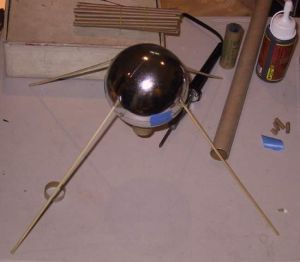
Brief:
This is an upscale of The Sputnik Too, by Estes: a spherical rocket. This version features a 24mm motor mount,
mid-body separation for deployment, and replaceable antenna legs.
Construction:
The main body is a chromed plastic oversized Christmas ornament. The four antenna legs are made from hardwood dowels.
Kevlar®
thread is used as a recovery harness. Gorilla Glue is used for construction.
Having seen other featherweight recovery versions of Sputnik designs, I immediately thought of an upscale when I saw the four inch diameter chromed plastic Christmas for sale after the holidays.
The sphere modifications will be described in terms of working on a globe with a motor mounted at the south pole. I wanted it to look more like the original Sputnik satellite than the typical styrofoam model. A central sphere with four back swept antennae form the simple design. My goal was to create a design with the antennae mounting north of the equator.
I started by sawing the sphere at a line midway between the equator and south pole. An X-Acto razor knife sliced through with minimal material loss.
I then used a hole saw to create a place for a 24mm motor mount in the south pole. A short section of motor mount was Gorilla Glued inside the sphere at the north pole. Another short section of motor mount was glued in the south pole hole. The installed motor casing forms the structural element holding the two sections of the sphere together.
A design goal was for the four antenna stabilizers to be field repairable. Cardboard tube sections cut from AeroTech Copperhead igniter packaging were used for antenna mounting sockets. Hardwood dowel antennae press fit into the sockets. Angled holes in the northern hemisphere were drilled and the tube sockets were Gorilla Glued into the northern hemisphere.
A launch lug is snugged up against the motor mount on both the top and bottom motor mounts. The two sphere sections must be rotated to align the launch lugs prior to putting it on the pad.
If truer to full scale, the antenna legs would be longer than what I used. I elected to shorten them to reduce weight and moderate the moment arm for torque on the antennas during recovery. To compensate for the shorter antennae, I taped small card stock tabs at the ends of the antennae.
I used several feet of Kevlar® thread glued at each end to the two sphere sections. A loop in that thread was used to attach a small parachute.
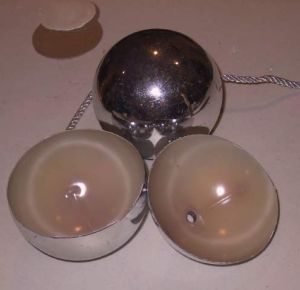

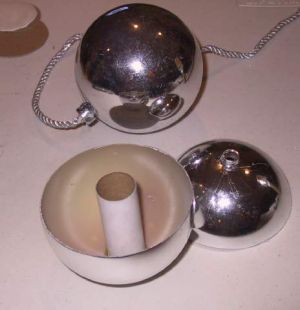
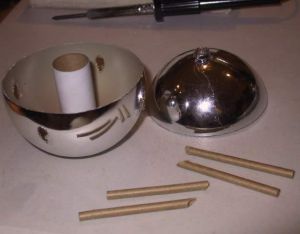
Finishing:
There is no finishing. The chromed sphere is the finish. The dowels may get some silver paint if it's convenient at
some time.
Flight and Recovery:
The casing is friction fitted into the top end of the southern motor mount. More tape is used to provide a friction
fit for the upper motor mount on the casing. The friction fit at both ends holds the sphere together.
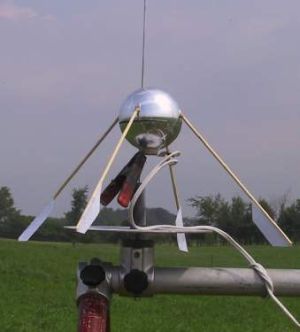 A parachute was packaged around the motor tube and casing inside the sphere.
A parachute was packaged around the motor tube and casing inside the sphere.
I initially used a 24mm to 18mm adapter to test fly the design on a C6-3. It flew respectably well, but the motor ejected as well as opening up the sphere. I have now modified the prep to add a tape thrust ring on the motor casing above the lower motor mount. The motor casing has not ejected in several subsequent flights. Based on initial stability, I trimmed some of the card stock antenna tabs off.
Moving to a D12-3 engine, the Sputnik 24 flew straight and true again. This time the Kevlar® thread was snapped at the lower motor mount by the ejection charge. The small section of sphere and motor casing recovered without damage by tumbling.
I replaced the lower recovery mount with a steel fishing leader and connected the recovery thread to that. After trimming some additional cardstock from the antennae stabilizers the Sputnik flew again on a D12-3. This time the ejection charge pulled the steel leader clip apart and the lower section of the sphere once again survived tumble recovery.
A flight on an E9-4 flew a long coning ascent, but once again separated the leader clip at ejection. After a lengthy search, the lower sphere section was found. Future flights will likely use two separate streamers to recover the two sphere sections.
Summary:
This is a distinctive rocket sitting on the pad. The mirrored chrome surface shines brightly. The flight is
surprisingly stable with the remaining small cardstock tabs. The hardwood dowels have survived all flights without
damage.
If there's a problem, it's in the exuberance of the Estes 24mm ejection charges. Since all but one flight has ended in split recovery, it seems that a streamer on the lower section will be sufficient to help locate it after separation.
Sponsored Ads
 |
 |











